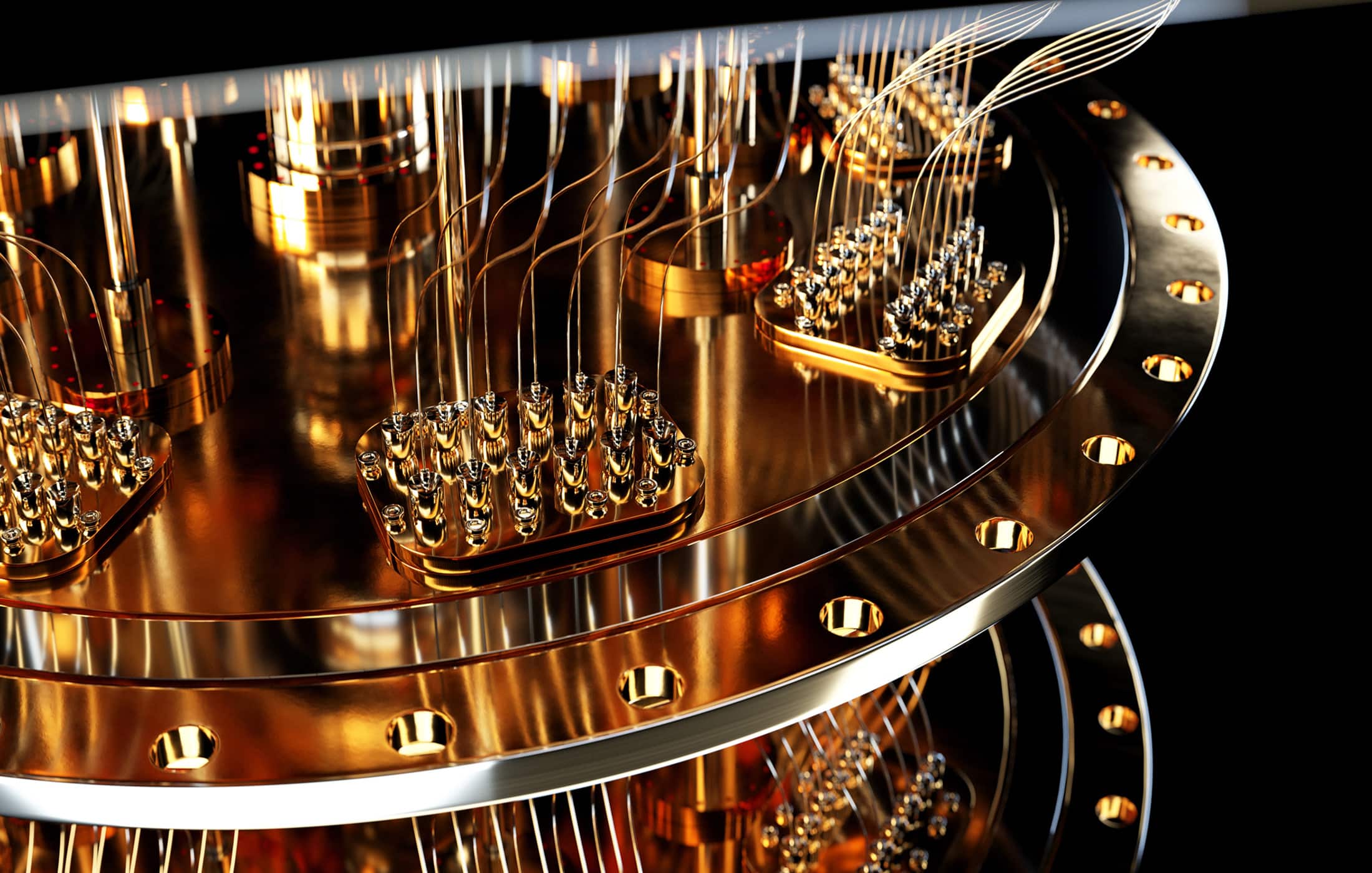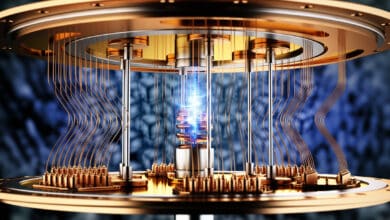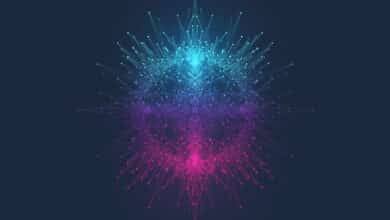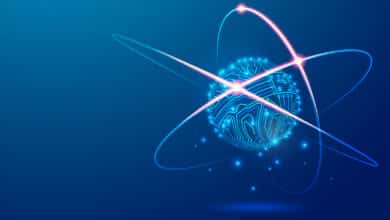Quantum Computing Modalities: Trapped-Ion QC

Table of Contents
(For other quantum computing modalities and architectures, see Taxonomy of Quantum Computing: Modalities & Architectures)
What It Is
Trapped-ion quantum computing uses individual ions (charged atoms) as qubits. Each ion’s internal quantum state (usually two hyperfine levels of the atom’s electron configuration) serves as |0⟩ and |1⟩. Ions are held in place (suspended in free space) using electromagnetic traps – typically a linear Paul trap that confines ions in a line using oscillating electric fields. By using lasers or microwaves to interact with the ions, quantum gates can be performed. Trapped ions are often called “nature’s qubits” because every ion of a given isotope is identical, and they have naturally long coherence times. This paradigm was one of the earliest proposed for quantum computing, with Ignacio Cirac and Peter Zoller’s famous 1995 paper outlining how to do a CNOT gate with trapped ions via a shared phonon mode.
Key Academic Papers
“Quantum computations with cold trapped ions” by J. I. Cirac and P. Zoller (Physical Review Letters, 1995) is the seminal proposal that showed a theoretically simple way to achieve a universal two-qubit gate in an ion trap. They proposed using two internal levels of each ion as qubit states and the collective quantized motion of ions in the trap as a “data bus” to mediate interactions. Specifically, by laser-cooling a string of ions to near the motional ground state, and then using laser pulses that couple an ion’s internal state to the motion (so-called sideband transitions), one can entangle any pair of ions. The Cirac-Zoller gate uses the first ion’s internal state to excite a shared vibrational quantum if in |1⟩, then flips the second ion conditioned on the vibrational excitation, and finally removes the vibration – resulting in an effective CNOT between the two ions. In the same year (1995), researchers at NIST (led by David Wineland) demonstrated the basic elements experimentally, entangling two ions’ states – this was the first demonstration of a quantum logic gate in any system. Another key milestone was the implementation of a controlled-NOT gate by Monroe et al. (1995/1997). Since then, trapped ions have consistently achieved record fidelities in quantum operations.
How It Works
A typical trapped-ion system starts by having a vacuum chamber with a trapping electrode structure (for example, four rod electrodes for radial confinement and endcap electrodes for axial confinement in a linear Paul trap). Ions (commonly used species include $$^{171}\mathrm{Yb}^+$$, $$^{40}\mathrm{Ca}^+$$, $$^{9}\mathrm{Be}^+$$, $$^{88}\mathrm{Sr}^+$$, etc.) are loaded, e.g. by vaporizing a neutral atom and ionizing it. The oscillating electric fields of the trap create a harmonic potential that holds the ions in a line, spaced by a few micrometers due to their mutual Coulomb repulsion. The qubit can be, for instance, two hyperfine ground states of $$^{171}\mathrm{Yb}^+$$ separated by a microwave frequency (about 12.6 GHz difference). These two hyperfine levels form an effective two-level system that is extremely stable (they are both ground states, so long-lived, differing only by nuclear spin orientation).
Single-qubit gates: These are typically done by applying a laser or microwave tuned to the qubit’s transition frequency to cause Rabi oscillations, rotating the qubit’s state. Because each ion is individually addressable by focusing a laser on it (or using tightly localized magnetic fields for microwave addressing), one can perform single-qubit X, Y, Z rotations with very high fidelity (over 99.99% reported in some experiments).
Two-qubit gates: The magic of ion traps is the collective motion. All ions in a trap chain are coupled by their mutual Coulomb force – they oscillate together at certain normal modes (vibrational eigenmodes). The simplest is the center-of-mass mode where all ions oscillate in unison. By using a bichromatic laser field (two frequencies) near the qubit transition, one can create a state-dependent force on the ions. This force will slightly displace the ions if they are in |1⟩ state and do nothing if in |0⟩ (for example). When two ions are both illuminated with such a laser, the process entangles their qubit states with the motion: the net effect (with proper tuning and timing) is that the motion returns to ground (disentangles) while the two qubits pick up a phase conditional on their states. This is essentially a Mølmer–Sørensen gate, a popular two-qubit entangling gate used in many modern ion experiments. The result is an entangled state, e.g. an XX gate which can produce a Bell state. In essence, the ions “talk” to each other via the motion bus: one ion’s state kicks the motion, another ion feels that motion and gets kicked in response, producing an entangling operation.
Mathematically, the Mølmer–Sørensen gate can be described by an effective Hamiltonian $$H \sim \sigma^x_i \sigma^x_j$$ for ions i and j for a duration, entangling their spin states. The Cirac-Zoller approach is more like a sequence involving $$\sigma^+ a$$ (spin raising and phonon creation) terms. Various techniques exist, but importantly any pair of ions in the chain can be entangled by using the right mode and laser sequence, giving essentially all-to-all connectivity (since in principle each ion interacts via shared modes with all others). This high connectivity is a big plus for ion-trap computers.
Measurement: Ions are typically read out by laser fluorescence. A laser is tuned to a transition that makes one qubit state (say |1⟩) fluoresce (a cycling transition) while the other state (|0⟩) remains dark. By collecting the emitted photons on a photodetector or camera, one can distinguish |0⟩ vs |1⟩ for each ion with very high accuracy (the bright state yields many photons, the dark yields few). This is a destructive projective measurement. Ions can then be reinitialized (usually by optical pumping to |0⟩).
Comparison To Other Modalities
Trapped-ion qubits are often considered the gold standard for coherence and fidelity. Qubits are stored in stable atomic energy levels which can have coherence times on the order of minutes or even hours (in sympathetic cooling scenarios or clock states) – indeed coherence of minutes has been reported for certain ion qubits. This vastly exceeds superconducting qubit coherence (microseconds) and even photonic circuits (where photons don’t “decohere” but can be lost easily). Two-qubit gate fidelities for ions have surpassed 99% in many labs, and single-qubit fidelities > 99.99% are routine, making them suitable for quantum error correction experiments already.
Another strength is uniformity: all ions of the same species are identical qubits, no fabrication variations. This means scaling in number doesn’t inherently degrade quality of each qubit (though controlling many lasers is challenging). Also, ions in a chain have an inherent all-to-all interaction via motion (as noted), whereas most other platforms have only local neighbor coupling – this can reduce the number of swap operations needed for distant qubits in an algorithm. Moreover, ion traps operate at room temperature vacuum chambers (the ions themselves need to be kept in vacuum and laser-cooled, but the setup is in a room-temperature environment, unlike milliKelvin for superconductors).
However, speed is a major difference: Ion gate times are typically in the few-microsecond (for single-qubit microwave gates) to tens or hundreds-of-microseconds range (for two-qubit gates using lasers), and sometimes even milliseconds if using certain gates. This is orders of magnitude slower than solid-state qubits. If one envisions needing billions of gate operations for error-corrected algorithms, this poses a time challenge. Additionally, while small numbers of ions (up to ~20-50) can be held in one trap, beyond that the mode spectrum becomes dense and gates slow down further, so scaling number of qubits in a single trap is non-trivial (the highest controlled entanglement to date is 32 ions in a chain). One scaling approach is modular ion traps: using multiple trap zones and shuttling ions between zones (transporting ions with electrodes – this has been done for say up to 50 zones with a few ions each, but it adds complexity and slows operation due to move times). Another approach is photonic interconnects between ion traps: entangling remote ions via photons (essentially quantum networking small ion modules). Companies like Quantinuum (Honeywell + Cambridge Quantum) use an architecture with multiple traps connected by physical movement of ions on a chip and swappable trap modules. IonQ, another company, currently uses a single chain of ~11–23 Yb+ ions (depending on device generation) and is exploring scaling via multiple chains and photonic links.
Compared to superconducting qubits, ion qubits are slower but more accurate and need far fewer physical qubits for error correction (because error rates are lower). Ions are also more flexible in connectivity (any-to-any within a trap vs fixed layout for superconductors). But superconductors currently have achieved higher raw qubit counts (tens vs low tens for ions). Also, superconductors benefit from fast classical electronics integration, whereas ion traps rely on bulk optics and precise laser systems that are not yet as compact (though efforts exist to miniaturize laser delivery).
Compared to photonic quantum computing, trapped ions are an example of matter qubits, which can be easily initialized and measured, whereas photons are flying qubits that need different techniques (and usually probabilistic gates). Ions can do deterministic gates with high fidelity, which is a big advantage for algorithmic quantum computing, whereas photonic approaches often struggle with probabilistic entanglement unless huge overhead is used. However, photonic systems might ultimately be easier to scale in parallel (since many photons can be generated and handled on optical chips, whereas ions you have to trap and control each one with careful hardware).
Current Development Status
Trapped-ion quantum computing is commercially active. Two prominent companies are IonQ (a U.S. startup out of University of Maryland and Duke University research) and Quantinuum (the merged Honeywell Quantum Solutions and Cambridge Quantum). IonQ’s current public devices have 11 algorithmic qubits (meaning 11 qubits fully connected, with gate fidelity high enough to treat all-to-all operations reliably; physically they can trap >20 but use error mitigation on 11). Quantinuum (formerly Honeywell) has the H1-1 and H1-2 machines with 10+ qubits and very high fidelities (~99.99% single, 99.7% two-qubit), and they have demonstrated entangling 6+ qubits and are working on larger next-gen systems (H2 with 32 qubits, planned 2024). Academic labs (like Rainer Blatt’s group in Innsbruck, Chris Monroe’s group now part of IonQ, Wineland’s former NIST group, etc.) have built systems of 20-50 ions and executed quantum algorithms and error-correction demonstrations. In 2021, the University of Innsbruck and Alpine Quantum Technologies unveiled a compact 19-inch rack ion trap system with 24 qubits, highlighting progress in miniaturization. The U.S. NIST group, as well as groups at Oxford, Maryland, etc., are pursuing advanced techniques like ion shuttling in microfabricated surface traps, which could enable 2D arrays of traps for larger processors. Trapped-ion tech is at a stage where small quantum algorithms (like chemistry simulation of a few molecules, optimization routines for ~10 variables, quantum error correction codes on few qubits) have been implemented with success. No large-scale fault-tolerant machine exists yet, but incremental scaling is ongoing. Notably, a record was set entangling 14 ions in a Greenberger–Horne–Zeilinger (GHZ) state in 2011, and more recently 24 or more ions in GHZ states. As mentioned, 32-ion entanglement (without full control between all unique pairs) has been reported as of 2023.
Advantages
The key advantages of trapped-ion modalities are:
- Established theoretical foundation: Trapped ions have been used as one of the primary testbeds for quantum information science. Many quantum error correction experiments (small Steane code, Shor code, repetition code demonstrations) and multi-qubit entanglement records have been done in ions. So the pathway to build a large-scale error-corrected ion-based quantum computer is well studied (e.g. the blueprint by Wineland and others using ion shuttling for error correction). This gives confidence that if engineering challenges are solved, the modality is sound for scaling.
- Exceptional fidelity and coherence: Ions have the lowest error rates of any qubit technology for small systems. They can maintain quantum states for long durations and perform hundreds of gates with minimal error accumulation. This means fewer qubits are needed for error correction, and near-term devices can explore deeper circuits before hitting noise walls.
- Uniform qubits and reconfigurable connectivity: Every ion is identical, eliminating manufacturing mismatches. In a single trap, any ion can interact with any other via the collective modes, effectively giving a fully connected register. This simplifies certain quantum algorithms and mappings (for example, in QAOA or variational circuits, one often needs a lot of entanglement between arbitrary pairs, which is natural on an ion trap but would require routing on a nearest-neighbor superconducting chip). Even in modular systems, connectivity can be extended via shuttling or photonic links.
- Relatively straightforward scaling of qubit count (in theory): To add more qubits, one can just load more ions or add more trap zones. Ions don’t “interfere” with each other in idle – having 100 ions in a chain is stable in principle (though gate speed suffers). There’s no physical wiring per ion; control is through electromagnetic fields, so in some sense an ion trap is a bit easier to scale in number than a system that needs a dedicated resonator and control line per qubit. (The hard part is controlling them well, not creating them).
- Room-temperature operation: The vacuum chamber and trap are at room temperature, and while lasers and control systems are complex, we avoid the dilution refrigerator of superconducting systems. This could make maintenance and operation somewhat easier (though lasers have their own headaches). Also, integrating classical logic (for feedback) is easier at room temp – in fact, some trapped-ion systems have demonstrated mid-circuit measurement and classical feed-forward, since one can measure an ion, do a quick classical calc, and apply a subsequent laser pulse all within coherence times.
Disadvantages
The challenges for trapped ions largely relate to scaling speed and infrastructure:
- Size of components: The wavelength of light used (often in the UV for Yb+ at 369 nm, or visible for Ca+ at 729 nm, etc.) sets a scale for focusing optics – one can only focus lasers so tightly. In practice, trap electrodes and vacuum windows etc. mean traps have ion separations maybe on order 5-100 micrometers and optical access. So while microfabricated traps exist, the overall system isn’t on the nanometer scale integration of silicon chips – it’s more mesoscopic. This might limit density of qubits per module (though with multiple traps networked, one can circumvent local density limits).
- Slow gate speeds: As noted, operations are much slower than solid-state qubits. This not only means longer run-times for algorithms, but also potentially more exposure to certain slow noise (e.g., magnetic field drift over milliseconds). Even though coherence is long, if one envisions running, say, a billion quantum gate operations (which might be needed for something like breaking RSA with error correction), at 100 μs per two-qubit gate that’s 100 billion μs ≈ 277 hours – clearly not practical unless gate speeds improve or algorithm steps reduce. There is research into using ultrafast laser pulses to do much faster gates (~1 ps pulses for stimulated Raman transitions), but it’s experimental.
- Difficulty of handling many ions: While adding ions is easy in theory, in practice a long chain of ions has closely spaced vibrational modes that make it harder to perform selective gates (crosstalk between modes can introduce errors). Also, more laser power and complexity is needed to address each ion without affecting neighbors as the chain grows. Shuttling ions in complex trap chips (like junctions and split traps) to form a scalable architecture is an engineering feat requiring precise control of ion motion and many electrodes. This has been demonstrated for a few zones but scaling to hundreds of zones is a project (Honeywell’s architecture is one of the most advanced in this regard).
- Bulky and delicate infrastructure: Ion traps currently rely on multiple stable lasers (for cooling, state preparation, gates, readout) which must be precisely tuned and phase-stable. These lasers and optical paths (mirrors, acousto-optic modulators, etc.) occupy large optical tables. While companies are working on compacting this (e.g. using fiber optics and integrated photonics to route lasers to trap chips), the fact remains that an ion quantum computer might look more like a lab experiment setup than a simple box, at least for now. Additionally, vacuum and trapping apparatus, while well-established (since ion traps come from atomic physics), add complexity – if a vacuum seal breaks, the ions are lost, etc. This is manageable but not trivial.
- Scaling control electronics: Each ion might need separate laser beams or frequencies for individual addressing as we scale up. Producing and controlling dozens of optical channels with high precision is costly (though it parallels telecom photonics in some ways). Furthermore, to do fast feed-forward or error correction, one may need fast detection and classical processing integrated; doing this for many ions in parallel is challenging (though not impossible – one can envision a CCD camera reading many ions simultaneously for measurement, but with limited temporal resolution).
Impact On Cybersecurity
Like other universal quantum computers, a large-scale trapped-ion computer could run Shor’s algorithm to break cryptographic codes. In fact, ion qubits’ high fidelities mean they have already factored small numbers and run quantum algorithms on few-qubit inputs. The limiting factor is scale – current ion machines have <20 qubits generally, which is far from what’s needed to threaten standard cryptography. But if ion traps can be scaled to, say, dozens of logical qubits through error correction, they might then be used to attack medium-size crypto (like RSA-512 or 1024). Many experts believe ion traps could be one of the first to demonstrate a fully error-corrected logical qubit because of their low physical error rates. Once error-corrected qubits are available, one can in principle scale up logical qubits by adding more ions and traps. However, given the slow operation speeds, a cryptographically relevant computation might be very lengthy unless parallelism or faster gates are achieved. Still, the threat is similar: by 2030s or 2040s, if ion trap quantum computers with perhaps several thousand qubits (error-corrected down to a few hundred logical) exist, they would pose a serious threat to RSA/ECC encryption. One can note that some key cryptographic experiments have been done: in 2016, Monz et al. used a trapped-ion device to factor 15 using 5 qubits (Shor’s algorithm with some classical help) – a trivial demonstration but a proof of concept. The timeline concerns for cryptography mostly generalize across modalities: it’s a race of scaling. Trapped ions may scale a bit slower in quantity but higher in quality; whether they reach the breaking point before or after superconductors is uncertain. In any case, the existence of multiple viable modalities (ions, superconductors, etc.) only increases the certainty that eventually large quantum computers will be built. Therefore, cryptographers are algorithm-agnostic in mitigation – they assume some quantum computer will succeed and prepare accordingly.
Future Outlook
Trapped-ion quantum computing is expected to steadily grow in qubit numbers and evolve in architecture. In the next 5 years, companies plan to push towards 50-100 ion systems either by using longer chains or multiple chains. For instance, IonQ has mentioned plans for a 64-qubit device using 4 chains of 16 ions each, connected optically. Quantinuum plans to combine two 32-qubit traps via photonic links to get 64 qubits. Academic proposals like the Quantum CCD (which shuttles ions between zones like moving data in a CCD chip) may be realized with 2D trap arrays. By ~2030, we might see ion trap processors with a few hundred physical qubits, possibly enabling a couple dozen logical qubits with error correction. If achieved, those could perform meaningful quantum chemistry beyond exact classical methods, or solve optimization problems via algorithms like QAOA with better quality. The modular quantum network approach is particularly promising: since ions can be entangled remotely by emitting photons and interfering them, one can imagine a distributed quantum computer of many ion traps connected by optical fibers – like a quantum version of a multi-core network. Such networked ion traps could circumvent the difficulty of one big trap and instead many small ones (each small trap remains high fidelity). In fact, the first demonstration of a quantum network (entangling ions in separate setups) was done in 2007 (Moehring et al.) and improved since.
One emerging trend is integrating more classical electronics with ion traps: e.g. putting photon detectors on-chip near the trap to quickly detect photons from ions, or using integrated waveguides to deliver laser light on the chip, making a “photonic chip trap”. These could drastically reduce the size of the setup. In the long run, trapped-ion systems might serve as quantum memory nodes or specialized processors even if other modalities dominate computing, because their stability is useful for memory (some envision hybrid systems where superconductors do fast operations and ions store quantum data longer).
In summary, trapped ions are a strong contender for building the first reliably controllable quantum computers at small scales, and they may well achieve the first logical qubit and small error-corrected algorithms. They might scale more gradually in number than solid-state systems, but their high fidelity means they could “overtake” others if those hit error barriers. Many experts see ions and superconductors as the two leading modalities currently, each likely to coexist and perhaps even complement each other. For the next decade, expect trapped-ion quantum processors to double or so in qubit count every couple of years, and keep setting records in gate fidelity. If topological qubits or other modalities don’t leapfrog, ion traps could remain one of the most trustworthy (if not the largest) quantum computing technologies into the 2030s.



